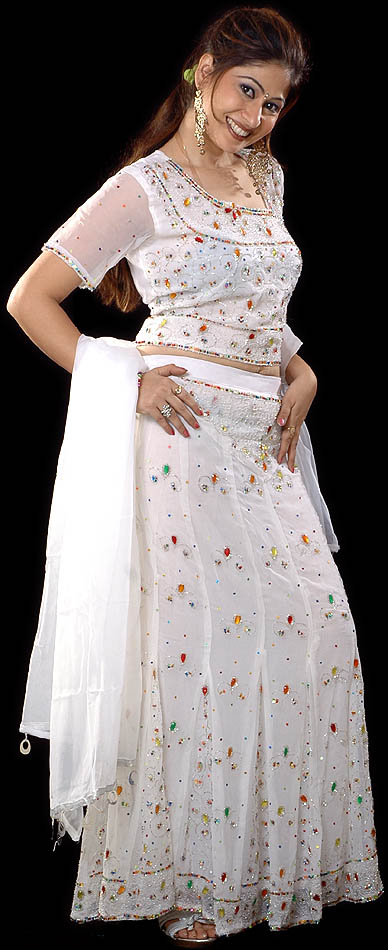New Lehenga Designs Definition
Source(Google.com.pk)All the details you need to know to help you get the wedding ensemble of your dreams...
For most brides the decision is not whether to wear a lehenga as their wedding outfit, but what kind of lehenga to choose – with panels or mermaid-cut? A backless or halter-neck choli? With gota or zardosi embroidery?
Tradition
Bridal attire consists of three parts: a ghaghra or lehenga (the full length skirt), the choli (close-fiited bodice) and the odhini or dupatta (the veil).
Lehenga
Traditional lehenga designs did not venture further than the full skirt. However, designers innovations with cut mean that you can now have as much as ten metres of fabric cut into panels to give volume or ghera to the skirt, without adding inches to the waist. The A-line and mermaid cuts both create a slim look while allowing for flowing movement. Another traditional variation of the lehenga is the sharara, (divided palazzo pants with wide flare from the knee), usually worn by muslim brides. This too, has been transformed in recent times, with a much more well-defined contemporary look.
Choli
The choli is essentially a bra styled garment, with strips across the back. The fashion was to wear the choli with either the ghaghra or a sari. The basic form of the choli, a tight fitted bodice, has remained unaltered over the centuries. However, designers are constantly experimenting with different length necklines, sleeves and backs and creating an endless variety to choose from.
Odhini
The odhini, dupatta or chunni is the final piece of the bridal ensemble. It is a long length of fabric tucked under the waistband of the lehenga and draped over the head, falling across the opposite shoulder. Richly embroidered and intricately woven with beautiful designs, the odhini is a piece of art in itself. A general rule to remember is that if your lehenga has a lot of embroidery, the odhini should be lighter in comparison, while a simpler lehenga could be matched with a heavily worked odhini.
Top tips for buying a lehenga
Fix a budget and stick to it. If you keep looking you will definitely find something within the limit you have set yourself
Spend time with the designer/consultant so that he/she knows exactly what you have in mind
Check the fabric as it is sometimes ignored due to the heavy embroidery
Ensure that the lehenga has a strong comfortable lining, which is important as it upholds the weight of the garment. The lining could be of satin or any soft fabric that sits gently and falls well. Inexpensive lehengas tend to be unlined.
Turn the lehenga inside out to check if the seams are well finished and that the waistband can carry the weight of the heavy embroidery. This is essential in order to avoid an embarrassing wardrobe malfunction on the day!
Make sure that the zardosi or beadwork does not prick or hurt your skin. Often the choli has embroidery under the arms, which can be uncomfortable to wear.
Lastly, check that the beadwork is well stitched into the fabric so that it doesn’t fall off easily
New Lehenga Designs Latest Designs Images Photos Pictures 2013
New Lehenga Designs Latest Designs Images Photos Pictures 2013

New Lehenga Designs Latest Designs Images Photos Pictures 2013

New Lehenga Designs Latest Designs Images Photos Pictures 2013

New Lehenga Designs Latest Designs Images Photos Pictures 2013

New Lehenga Designs Latest Designs Images Photos Pictures 2013

New Lehenga Designs Latest Designs Images Photos Pictures 2013

New Lehenga Designs Latest Designs Images Photos Pictures 2013

New Lehenga Designs Latest Designs Images Photos Pictures 2013

New Lehenga Designs Latest Designs Images Photos Pictures 2013
New Lehenga Designs Latest Designs Images Photos Pictures 2013
No comments:
Post a Comment